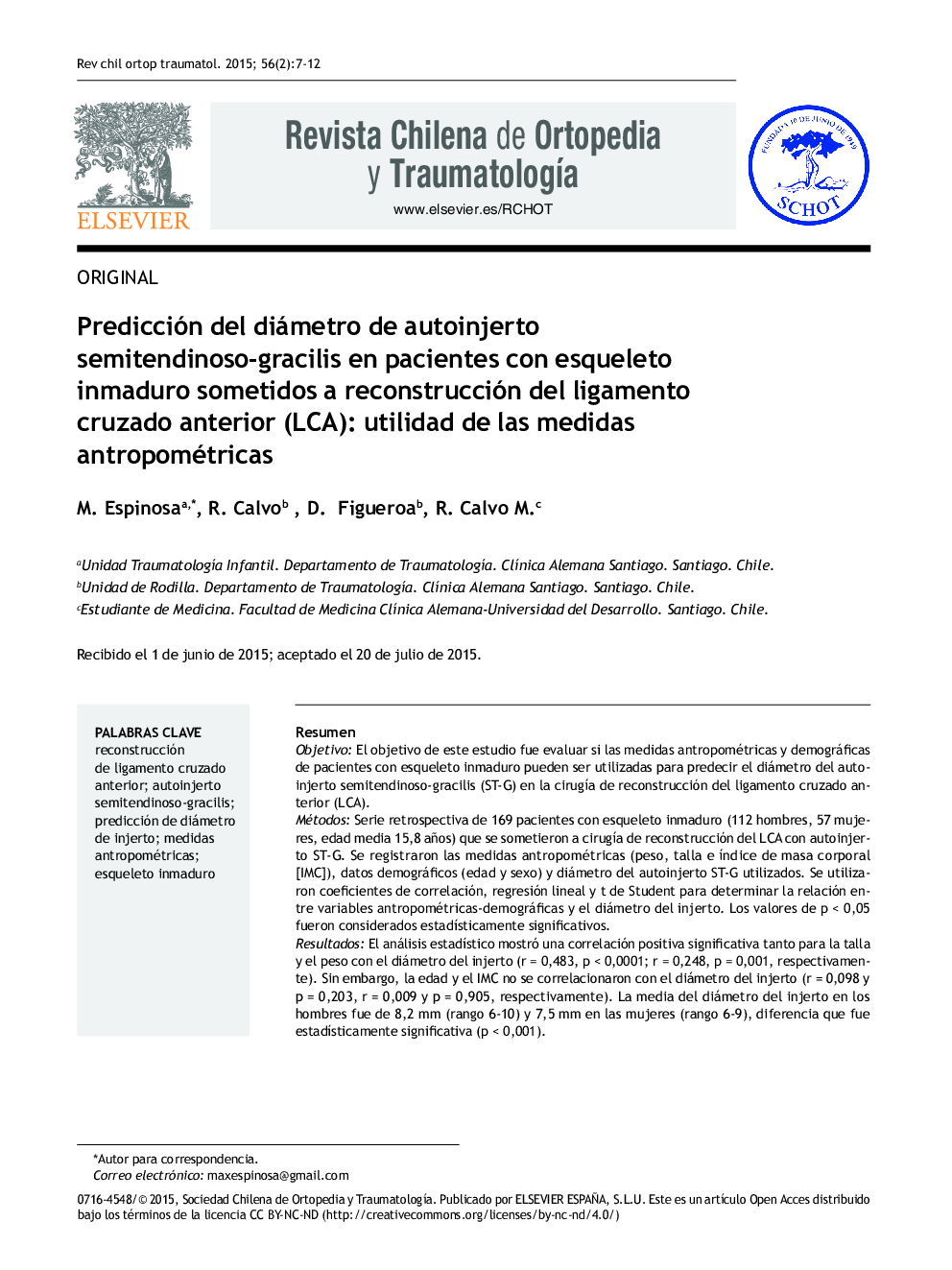| کد مقاله | کد نشریه | سال انتشار | مقاله انگلیسی | نسخه تمام متن |
|---|---|---|---|---|
| 4086012 | 1267918 | 2015 | 6 صفحه PDF | دانلود رایگان |

ResumenObjetivoEl objetivo de este estudio fue evaluar si las medidas antropométricas y demográficas de pacientes con esqueleto inmaduro pueden ser utilizadas para predecir el diámetro del autoinjerto semitendinoso-gracilis (ST-G) en la cirugía de reconstrucción del ligamento cruzado anterior (LCA).MétodosSerie retrospectiva de 169 pacientes con esqueleto inmaduro (112 hombres, 57 mujeres, edad media 15,8 años) que se sometieron a cirugía de reconstrucción del LCA con autoinjerto ST-G. Se registraron las medidas antropométricas (peso, talla e índice de masa corporal [IMC]), datos demográficos (edad y sexo) y diámetro del autoinjerto ST-G utilizados. Se utilizaron coeficientes de correlación, regresión lineal y t de Student para determinar la relación entre variables antropométricas-demográficas y el diámetro del injerto. Los valores de p < 0,05 fueron considerados estadísticamente significativos.ResultadosEl análisis estadístico mostró una correlación positiva significativa tanto para la talla y el peso con el diámetro del injerto (r = 0,483, p < 0,0001; r = 0,248, p = 0,001, respectivamente). Sin embargo, la edad y el IMC no se correlacionaron con el diámetro del injerto (r = 0,098 y p = 0,203, r = 0,009 y p = 0,905, respectivamente). La media del diámetro del injerto en los hombres fue de 8,2 mm (rango 6-10) y 7,5 mm en las mujeres (rango 6-9), diferencia que fue estadísticamente significativa (p < 0,001).ConclusionesLa predicción del diámetro del injerto ST-G según la talla del paciente es un método fácil y fiable en pacientes con esqueleto inmaduro. Estos datos pueden proporcionar información preoperatoria relevante sobre la necesidad de una técnica para aumentar el injerto ante un eventual diámetro insuficiente de este.
PurposeThe aim of this study was to evaluate whether the anthropometric and demographic measures of patients under 18 years old can be used to predict the diameter of semitendinosus-gracilis (ST-G) autografts in anterior cruciate ligament (ACL) reconstruction surgery.MethodsA study was conducted on retrospective series of 169 patients under 18 years (112 men, 57 women, average age 15.8 years) who underwent to ACL reconstruction surgery with ST-G autograft. The anthropometric measurements were recorded (weight, height and body mass index), demographics (age and gender) and the diameter of the ST-G used. Correlation coefficients, linear regression and unpaired t-test were used to determine the relationship between anthropometric/demographic variables and the diameter of the graft. P values <.05 were considered statistically significant.ResultsCorrelation analysis showed a significant positive relationship between height and graft diameter (r=0.483, P<.0001), as well as between weight and graft diameter (r=0.248, P=.001). However, age and body mass index (BMI) did not correlate with graft thickness (r=0.098 and P=.203, r=0.009 and P=.905, respectively). The mean graft diameter in men was 8.2 (range 6-10) and 7.5 in women (range 6-9), a difference that was statistically significant (P<.001).ConclusionsPrediction of the ST-G graft diameter according the height of the patient is an easy and reliable method in children and adolescents. These data can provide relevant preoperative information on the need for an alternative graft source for an eventual insufficient diameter of the latter.
Journal: Revista Chilena de Ortopedia y Traumatología - Volume 56, Issue 2, May–August 2015, Pages 7–12